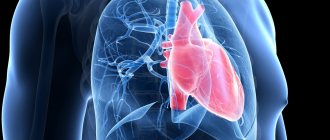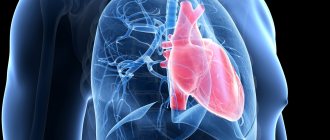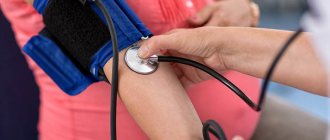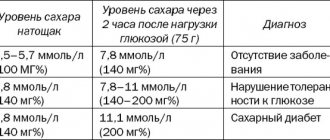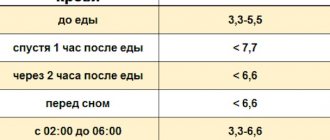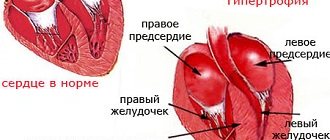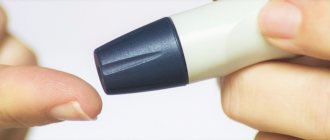Diabetes mellitus is common in patients with hypertension and significantly increases the risk of cardiovascular disease, including myocardial infarction, stroke, and peripheral vascular disease. Pharmacological therapy in patients with hypertension and diabetes is controversial due to concerns about the metabolic effects of some antihypertensive agents, as well as concerns about the safety of calcium antagonists. Therefore, diet, lifestyle changes and knowledge about proper prevention of disease progression are the key to maintaining health and reducing the risk of developing cardiovascular complications.
Factors affecting blood pressure
The cause is unknown in most cases. This is called essential hypertension. The pressure in the blood vessels depends on how hard the heart pumps blood and how much resistance the blood vessels (arteries) offer. The slight narrowing of the arteries is thought to increase resistance to blood flow, which increases blood pressure.
What Causes High Blood Pressure?
Most people don't have a single reason. However, there are a number of things that increase the likelihood of its occurrence. These are the so-called risk factors:
- The influence of nicotine.
- Excessive consumption of salt or processed foods (convenience foods, canned foods, smoked foods).
- Alcohol abuse.
- Having excess weight.
- Insufficient physical activity.
- Private stress, which provokes the release of adrenaline and cortisol.
In addition, diabetic nephropathy, a complication that develops in some people with diabetes, can cause hypertension in patients with diabetes. In this condition, the kidneys are damaged, which can cause high blood pressure due to damage to the arteries, arterioles, tubules and glomeruli of the kidney tissue. It is more common in people with type 1 diabetes. In rare cases, high blood pressure is caused by other medical conditions. This is then called secondary hypertension. For example, kidney problems or hormonal imbalances can cause high blood pressure.
Hypertension and diabetes mellitus
Hypertension in patients with diabetes is an integral and very dangerous component, which can several times increase the risk of developing the following diseases:
- 3-5 times - heart attack;
- 3-4 times - stroke:
- 10-20 times - blindness;
- 20-25 times – renal failure;
- 20 times - gangrene, requiring limb amputation.
If blood pressure readings exceed 140/90, there is no need to hesitate to contact a specialist, since hypertension that occurs against the background of diabetes mellitus can lead to the development of irreversible consequences, often incompatible with life.
The maximum threshold for blood pressure in patients with diabetes is considered to be values not exceeding 130/85. In case of higher values, antihypertensive therapy for diabetes mellitus is necessary.
How is blood pressure measured?
Blood pressure is measured using a device called a tonometer. A cuff (thick tape) is placed on the arm.
As air is inflated, the cuff tightens and then slowly relaxes again. During this relaxation, you can listen to the pulsation of the arteries and record the first and last tone to record blood pressure readings. Blood pressure is measured in millimeters of mercury. After the study, the result will be recorded in two numbers: the first is systolic pressure (during ventricular contraction), the second is diastolic pressure when the heart muscle is at rest. According to the principle of operation, tonometers are automatic and manual. When using a manual tonometer, air is pumped using a special bulb, and the first and last tone is heard using a stethoscope.
The automatic blood pressure monitor inflates the cuff and catches the pulse itself. Also, such devices measure heart rate and have a built-in memory for recording readings. It is much more convenient than manual ones, especially for older people.
About the types of blood pressure medications
The leading drugs are diuretics, that is, having a diuretic effect, as well as beta-type blockers, calcium antagonists, otherwise called calcium channel androgens. In addition, this category includes ACE inhibitors and angiotensin II receptors, which can block them.
The combination treatment includes additional types of drugs: rasilez (which is also a direct renin inhibitor), alpha adrenergic blockers, as well as agonists that provide a targeted effect on the nervous system. All these medications should be used only in accordance with medical recommendations. Otherwise, the negative impact can be very significant.
Thus, to lower blood pressure in both types of diabetes, drugs from the following groups are usually used:
- inhibitors: Enalapril, Captopril;
- diuretics: Diacarb, Furosemide;
- beta blockers: “Dilatrend”, “Trandat”, “Nebilet”;
- calcium antagonists: Verapamil, Diltiazem;
- alpha-blockers: Terazosin, Prazosin, Doxazosin;
- stimulants (agonists) of imidazoline receptors: Physiotens, Albarel.
Each group of drugs will be discussed in detail below.
Treatment and prevention of high blood pressure
To avoid a diagnosis of hypertension, patients with diabetes need to adjust their lifestyle in the following ways:
- Maintain a healthy weight. Overweight people should try to lose weight, while people of normal weight should avoid gaining weight. If you are overweight, losing just 5 kg can help prevent hypertension. Talk to your doctor about the most appropriate weight for you.
- Eat a balanced diet. Eat plenty of fruits and vegetables, especially those rich in potassium, and limit your intake of excess calories, fat and sugar. Consider following the Dietary Approaches to Control Hypertension, or DASH diet, which has been shown to help control blood pressure in patients with diabetes.
- Reduce the amount of salt. A low-sodium diet can help maintain normal blood pressure. The higher your sodium intake, the higher your blood pressure. You can reduce your overall salt intake by avoiding packaged and processed foods that are high in sodium and not adding extra salt to your meals.
- Exercise regularly. Get moving to prevent hypertension. Physical activity is critical. The more you exercise, the better, but even light exercise can help control your blood pressure. Moderate exercise for 30 minutes three times a week is a good start.
- Limit your alcohol intake. Excessive alcohol consumption can lead to high blood pressure.
- Check your blood pressure regularly. If your doctor detects early signs of hypertension (prehypertension), additional precautions may be needed to correct the condition.
Take a look at your lifestyle and decide where you can make changes to prevent hypertension. Achieve small goals, like snacking on fruits and vegetables instead of junk food, and continue to practice these healthy habits until they become part of your daily life.
About therapeutic methods
One of the most effective ways to combat blood pressure in diabetes mellitus is strict adherence to the principles of a dietary diet. In this case, we are talking about a low-carbohydrate diet, and it is suitable only for those patients who do not yet have renal failure.
The presented nutritional features are completely safe and useful also at the stage of microalbuminuria. This is explained by the fact that when blood glucose decreases to normal values, the kidneys begin to work quite optimally.
Because of this, the proportion of albumin found in urine returns to normal, which also has a positive effect on high blood pressure.
Weight loss will improve the patient's overall condition.
Maintaining a healthy lifestyle and maintaining the correct daily routine, playing sports, and physical activity have a positive effect on blood vessels and reduce blood glucose levels.
When choosing specific pills and drugs, the doctor must take into account how exactly the patient controls the process of diabetes, and whether he has satellite diseases formed in addition to hypertension. In this regard, we can say with confidence that blood pressure medications must meet the following indicators:
- significantly reduce blood pressure, but so that along with this there is a minimum number of negative manifestations;
- do not affect the deterioration of blood glucose control and do not increase the proportion of “bad” cholesterol and triglycerides;
- create complete protection for the kidneys and heart from the harm that both diabetes and rapidly developing high blood pressure can cause them.
There are currently eight categories that include medications for hypertension. Five of them are basic, three are additional. Blood pressure medications for diabetes mellitus, which are considered additional, should be used primarily as a mixed treatment. It is important to follow all doctor's recommendations. In this case, blood pressure in diabetes mellitus will be effectively brought to normal levels.
Treatment with medications
If you have diabetes, the use of antihypertensive therapy is recommended in cases where blood pressure remains at 140/80 mmHg. even when adjusting your lifestyle through diet, exercise, etc. Target blood pressure is below 130/80 mm Hg. Art. is mandatory if the patient has complications such as damage to the retina, kidney (nephropathy) or brain tissue (stroke).
There are several different medications that can lower blood pressure readings. The choice depends on things like:
- Do you have other health problems?
- Are you taking other medications?
- Possible side effects of the medicine.
- Patient's age and ethnicity.
The first group of drugs that is most often used is a drug called an angiotensin-converting enzyme (ACE) inhibitor. ACE inhibitors protect against kidney damage and also help control blood pressure.
One drug lowers blood pressure to target less than half the time. Therefore, this means that two or more different medications are usually required to achieve the target level (140/80 mmHg or below). In about a third of cases, three or more medications are needed to lower blood pressure to target levels. Therefore, patients with a combination of diabetes mellitus and arterial hypertension need regular consultations with doctors to monitor their health status and adjust treatment.
Hypertension in diabetes: features
In patients with diabetes mellitus, there is a disturbance in the natural daily rhythm of blood pressure fluctuations. In a healthy person, blood pressure levels in the morning and at night are usually 10-20% lower than in the daytime. In patients with diabetes, there is no decrease in blood pressure at night. Moreover, their nighttime pressure readings may be even higher than their daytime ones. According to experts, this phenomenon is caused by diabetic neuropathy. An increased concentration of sugar in the blood leads to damage to the autonomic nervous system, which is responsible for regulating the body's vital functions. There is a deterioration in the ability of blood vessels to regulate their tone - narrowing and relaxing depending on the load.
Therefore, hypertensive patients suffering from diabetes mellitus need to not only measure their blood pressure once, but also monitor it around the clock. This study allows us to determine at what time and in what dosages it is better to take antihypertensive drugs for type 2 diabetes.
Calcium antagonists
They slow down the flow of calcium into cells, which dilates blood vessels and reduces pressure. The following groups are distinguished:
- non-dihydropyridine - reduce heart rate, can be used to treat hypertension, which appears with nephropathy, and help avoid renal damage in diabetes;
- dihydropyridine - increase heart rate, reducing the likelihood of a heart attack.
Both are allowed to be used along with diuretics and ACE inhibitors. Prohibited for use in cases of unstable angina and heart failure.
Non-dihydropyridine blockers should not be prescribed along with beta blockers. Many people are interested in what blood pressure pills to take for diabetes.
ACE inhibitors
They block an enzyme involved in the synthesis of angiotensin, which causes an increase in blood pressure. Medicines prevent complications in the heart and kidneys. During administration, the sugar content does not increase.
ACE inhibitors have a mild hypotensive effect; after two weeks a persistent decrease in blood pressure is achieved. In both types of diabetes, these medications are prohibited if renal artery stenosis and hyperkalemia have been diagnosed. It must be taken into account that in severe hypertension, ACE inhibitors will not have a therapeutic effect. In some patients they cause cough.
What other medicine for blood pressure in diabetes mellitus is effective?
